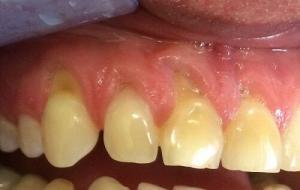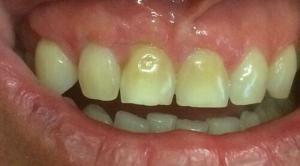Gum Recession
Gum Recession
Gum recession in the past was frequently blamed on incorrect tooth brushing using firm brushes in a scrubbing technique. It was assumed that this damaged the gums and the attachment to the root surface of the tooth. However this is often untrue and generally not supported by scientific evidence. While incorrect brushing will result in plaque being left on the roots and between the teeth, it is the plaque that is retained that caused the gum to become inflamed and it is the inflammation that leads to a loss of the attachment of the soft tissues to the root surface. Hence gum disease is the real reason in many cases and not hard tooth-brushes.
Gum recession can take place for a number of other reasons including:
- gum disease, with inflammation causing damage to the attachment of the gum to the root of the tooth,
- genetic or congenital recession due to anatomically thin bone over the roots of a tooth,
- orthodontic repositioning of teeth leaving some teeth out of the previous “bone position”
- tension applied to the gum tissues due to a muscular attachment to the jaw bone at the site of a frenum, most commonly in the upper jaw in the midline, but it can occur at other frenum sites
- trauma from tongue piercing jewellery can damage the gum attachment to the roots of the lower incisors on the tongue side
- Use of certain recreational drugs including cocaine that are rubbed onto the gum in the cheek for absorption and this may affect the tissues leading to recession,
- After surgery in the mouth due to a combination of trauma from the incisions and a mildly compromised blood supply to the tissues.
The repair of recession is achieved using a connective tissue graft that may be obtained in three ways:
- First, graft tissue may be harvested from a patient’s own tissues known as an autograft (same individual). The deep surface of the same patient’s palate (roof of the mouth) may be used as an autograft tissue donor site.
- Secondly a graft tissue may be obtained from suitably prepared collagen from an animal model most commonly the pig, known as xenograft (different species) including products such as “Mucograft” (manufactured by Geistlich). There is the additional cost for the graft that is borne by the patient in addition to the cost of surgery.
- and finally human donated and suitably prepared tissue called an allograft (same species but different individual) may be used as the graft. This includes tissue products like Allograft (supplied by BioHorizons). Again the cost is borne by the patient. Some patients feel uncomfortable having human donor tissue used but human graft tissue is not uncommon with other donor tissues including eye corneal tissue, and of course liver and lung translants. Due to the preparation of this connective tissue graft there are no rejection problems and no need for anti-rejection drugs.
All three techniques work well in different clinical situations.
The benefit of using either a xenograft or allograft is the avoidance of a second surgical site for harvesting grafting tissue in the same individual so that there is less oral discomfort and less opportunity for post-operative bleeding, swelling or infection.
The benefit of a xenograft (collagen) graft is the avoidance of a harvest site and the avoidance of using donated human tissue.
Depending on patients’ preferences, Dr. Colin Priestland finds the best results for small grafts are achieved using autografts. Larger grafts are best achieved by both xenografts and allografts.

Severe recession affecting the upper right canine and three incisors

The same patient following autograft surgery and 7 weeks healing, root coverage has been achieved, although healing is still incomplete.
Soft tissue and bone grafting, are particular interests of Dr. Colin Priestland who is a senior lecturer at the James Cook University Dental School teaching on the postgraduate diploma course in implantology. He has been involved in this field of surgery since 1990 and has continued attending courses, symposia, and conferences to ensure he is able to provide the most up to date therapy for his patients. Dr Priestland trained under Dr P Edward “Pat” Allen DDS PhD who pioneered the surgical coverage of severe recession defects in the USA.
If you would like to know more about recession treatment contact the practice on 07 4725 1656, or contact us through our website online at www.nqsurgicaldentistry.com.au
Contact the friendly team at NQ Surgical Dentistry today on (07) 4725 1656 or call in to see us at 183 Kings Rd, Pimlico QLD 4812
BOOK AN APPOINTMENT
CALL US TODAY 07 4725 1656
